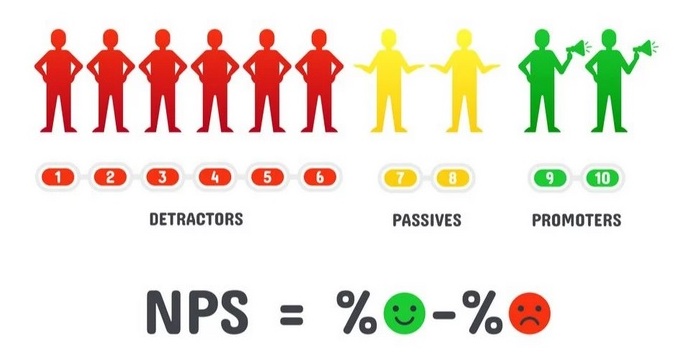Making an argument in support of excellent customer experience (CX) is not hard at all. In fact the majority of organisations already consider CX to be the main driver of competitive advantage, according to Gartner.
However, CX is a moving target and monitoring customer satisfaction is less straight forward than, say, excess inventory or sales growth. CX is multi-faceted so it’s logical that a comprehensive CX picture means customer experience benchmarking from several angles.
But which metrics are worth measuring, and what set of metrics will build a sufficiently comprehensive picture of how customers feel about your brand? We think each of the following five metrics provide key CX insights, and a rounded picture when evaluated together.
The Net Promoter Score (NPS)
Your customers will only recommend your product or service to friends and colleagues if they’re confident of a good customer experience. On the flip side, your customers will also broadcast poor experiences, probably more so than positive ones. The Net Promoter Score (NPS) measures how willing existing customers are to recommend your company.
Customers rate their willingness to recommend your brand on a scale of 0 to 10, with scores of six and below classified as “detractors”, scores of 7 or 8 taken as passive customers (who would easily switch) while those answering 9 or 10 are classified as promoters. Calculating the NPS score subtracts the percentage of customers who are detractors from the percentage who are promoters.
The resulting Net Promoter Score is a somewhat blunt yet very authentic indicator of the overall customer experience. Interestingly, the consulting firm that developed the system, BAIN, has backed up the theory of NPS by demonstrating that NPS correlates with business growth. Notably, NPS also includes an open text field just after the score, which can add colour to the CX picture. NPS should be your first port of call when measuring CX.
Churn and Retention Rates
Churn and retention rates are two sides of the same coin and both somewhat mirror NPS as a representation of the overall CX. In churn, companies measure the percentage of customers that leave a service over a set period. Retention reflects the percentage of customers that are still with the company, again over a pre-determined period.
The factors behind customer churn are myriad, but churn (and retention) is a key indicator for two important reasons. First, it goes without saying that customers tend to leave because they are dissatisfied, so churn and retention reflects the customer experience to at least some degree. Furthermore, acquiring new customers to replace the customers that your company couldn’t retain is expensive so it’s imperative to focus on reducing churn.
Customer Satisfaction (CSAT)
In trying to determine the reasons for customer churn one score companies could look at is the customer satisfaction score (CSAT). Customer satisfaction is typically measured on a five-point scale – from poor to excellent. It’s a simple measure that is fast to answer which means you maximise the number of responses. High response rates give a bigger, more valid picture of any given measure.
CSAT scores are typically measured after a customer service experience, such as a call to a Contact Centre. However, companies can take a CSAT score at any time so CSAT can provide a valuable point of measurement across customer touch points. In other words, CSAT can help companies determine where customer pain points are.
The Customer Effort Score (CES)
Both CSAT and NPS provide a very balanced view of CX, reflecting both the positive aspects and the negatives aspects of the customer experience. While the customer effort score (CES) may seem similar to CSAT, it provides a more accurate indicator of the aspects that detract from a good CX.
In a twist on CSAT, the customer effort score asks customers to rate their experience on a scale from very difficult, to very easy. In other words, CES asks customers how much of an effort it was to use your product or service, or to resolve their customer service issue.
Why is CES a valuable metric? Well, for many products or services a good CX is largely reflected by how easily a customer gets the job done. In other words, it is not about bells and whistles but about efficiency. Here CES can deliver a more accurate picture of how well your company serves its customers.
Customer Lifetime Value (CLV)
Measuring the predicted net profit across the lifetime of a customer relationship is known as the customer lifetime value or CLV. Each company will choose to measure CLV in a slightly different way, but CLV provides two important insights.
First, while many aspects of the customer experience will respond positively to investment, excessive investment will reduce profitability. So, monitoring the overall profitability of your customers can help guide investment to get the maximum return.
Furthermore, while some customers will continue to make use of your product or service even if CX dips, they may spend less – or spend more, depending on the customer experience. Gauging the lifetime value of customers over time is, therefore, a useful way to measure whether customers are merely tolerating your customer experience – or are in love with it.
Responding to Customer Satisfaction Metrics
As we said at the outset, each of the above metrics will provide a particular view of the customer experience. And, though a metric will capture a customer’s given experience at a specific point in time, it will inevitably reflect past experiences too.
The best way to use customer experience tools is, therefore, to continuously, consistently monitor several metrics over a long period of time.
Only by monitoring the customer experience from multiple angles, and over a long period of time, can companies get a comprehensive picture – and a picture that they can rely on when building their CX strategy.








